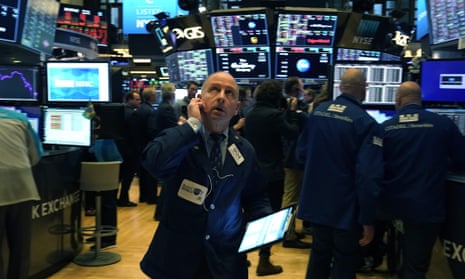Panic over the coronavirus on global financial markets amid the biggest market crash in a generation has forced the US central bank to inject trillions of dollars into bond markets in a dramatic attempt to prevent a repeat of the 2008 credit crunch.
As stock prices plunged around the world on Thursday, with both the London and New York markets suffering their worst day since the Black Monday crash of October 1987, the New York Federal Reserve said it would pump $1.5tn (£1.2tn) into the American financial system to stop markets from freezing up.
It came after the European Central Bank failed to reassure panicked investors with a botched rescue package, as the coronavirus death toll climbs and more countries impose emergency travel bans and outlaw large public gatherings.
The FTSE 100 index of leading UK company shares lost 10.87% on Thursday in the second biggest rout on record, taking total losses on the London market since mid-February – before the severity of the coronavirus outbreak became evident – to more than £540bn. The index closed down more than 600 points at 5,237, the lowest level since 2012. The Dow Jones in New York closed down 10%, losing 2,352 points to 21,200.
The Euro STOXX 600 index, which tracks all stock markets across Europe including the FTSE, fell by 11.48% – the worst day since it launched in 1998. The panic selling prompted by the coronavirus has wiped £2.7tn off the value of STOXX 600 shares since its all-time peak on 19 February.
“Today has been utterly brutal,” said Neil Wilson, chief market analyst of the online trading platform Markets.com. “Markets are at breaking point, there is a real systemic risk now with financial markets in complete turmoil over the coronavirus.”
In the most significant intervention to date, the New York Fed said it would offer three blocks of $500bn into an arm of the financial markets which allows banks to exchange government bonds for cash. It came amid signals that the international financial system was coming under severe strain from some of the most extreme movements in stocks and bonds for a generation.
Governments and companies use bond markets to borrow money from investors. In the 2008 credit crunch, banks stopped lending to one another as panic spread through the system. The Fed warned it had identified “highly unusual disruptions” amid widespread concern over the unfolding economic damage from Covid-19.
However, the move provided only a brief respite for share prices on Wall Street, before the Dow plunged again in what also turned out to be its worst day since 1987.
European markets suffered the steepest losses, with shares in France and Germany plummeting by 12%, in Spain by 14% and Italy – at the heart of the outbreak in Europe – falling by almost 17% in its worst day on record.
The trigger for market turmoil came after Donald Trump unveiled a unilateral ban on travel from 26 EU countries, sparking renewed stock market panic after a week of heavy selling pressure, as tensions rise between nations over the best way to respond to the virus.
The pound also suffered, falling by about 2 cents against the US dollar to $1.259 – its lowest since October – as investors sought safety in the American currency, which is typically regarded as a safe haven during times of heightened financial turmoil. The rush to buy dollars also pushed down the euro by 1.5%, back below $1.11.The widespread losses came despite the ECB becoming the latest global central bank to unleash emergency stimulus measures, following efforts by the Fed and the Bank of England, which announced an emergency cut in interest rates on Wednesday alongside Rishi Sunak’s expansionary budget.
The stimulus measures to try to prop up the fragile eurozone economy included loosening restrictions on lending by banks in the currency bloc, and buying more private sector bonds.
However, the ECB president, Christine Lagarde, did not unveil the interest rate cut expected by investors and called instead for eurozone governments to step in with increased spending.
The normally sure-footed Lagarde came under fire after she refused to echo her predecessor, Mario Draghi, and say the bank would do whatever it takes to protect the eurozone from a recession.
Referring to calls for the ECB to help ease borrowing costs for highly indebted eurozone countries, Lagarde said: “We are not here to close [bond] spreads, there are other tools and other actors to deal with these issues.”
The cost of borrowing for the Italian government soared, sparking fears of a repeat of the 2012 eurozone debt crisis when the then ECB boss, Draghi, declared he would do “whatever it takes” to preserve the euro.
Claus Vistesen, chief eurozone economist at the consultancy Pantheon Macroeconomics, said the ECB chief’s intervention was a “disaster” given the scale of the challenge facing the global economy.
“[Her] performance will go down as a catastrophic failure by part of the ECB. It is one of the world’s largest central banks, and today markets were crying out for a backstop; they got anything but,” he said.
Banking bosses from lenders including Barclays, HSBC, Lloyds and Natwest were summoned by Rishi Sunak and Mark Carney, the governor of the Bank of England, to discuss coordinated action to support small businesses.
The group of lenders, which also included Santander, Virgin Money and Danske Bank, confirmed they were making more than £20bn available for companies that needed emergency financing over the coming months.
